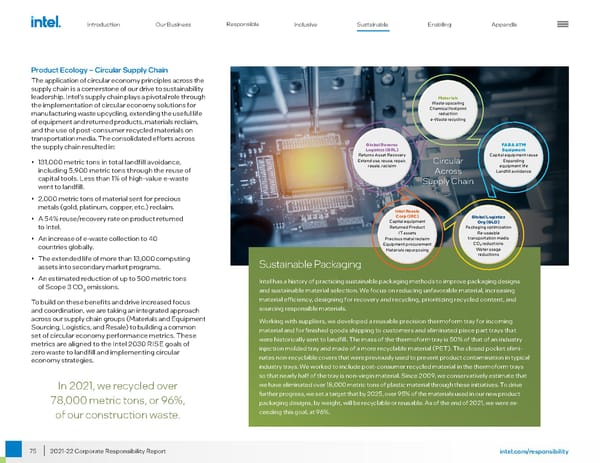75 intel.com/responsibility 2021-22 Corporate Responsibility Report Product Ecology – Circular Supply Chain The application of circular economy principles across the supply chain is a cornerstone of our drive to sustainability leadership. Intel’s supply chain plays a pivotal role through the implementation of circular economy solutions for manufacturing waste upcycling, extending the useful life of equipment and returned products, materials reclaim, and the use of post-consumer recycled materials on transportation media. The consolidated efforts across the supply chain resulted in: • 131,000 metric tons in total landfill avoidance, including 5,900 metric tons through the reuse of capital tools. Less than 1% of high-value e-waste went to landfill. • 2,000 metric tons of material sent for precious metals (gold, platinum, copper, etc.) reclaim. • A 54% reuse/recovery rate on product returned to Intel. • An increase of e-waste collection to 40 countries globally. • The extended life of more than 13,000 computing assets into secondary market programs. • An estimated reduction of up to 500 metric tons of Scope 3 CO 2 emissions. To build on these benefits and drive increased focus and coordination, we are taking an integrated approach across our supply chain groups (Materials and Equipment Sourcing, Logistics, and Resale) to building a common set of circular economy performance metrics. These metrics are aligned to the Intel 2030 RISE goals of zero waste to landfill and implementing circular economy strategies. In 2021, we recycled over 78,000 metric tons, or 96%, of our construction waste. Sustainable Packaging Intel has a history of practicing sustainable packaging methods to improve packaging designs and sustainable material selection. We focus on reducing unfavorable material, increasing material efficiency, designing for recovery and recycling, prioritizing recycled content, and sourcing responsible materials. Working with suppliers, we developed a reusable precision thermoform tray for incoming material and for finished goods shipping to customers and eliminated piece part trays that were historically sent to landfill. The mass of the thermoform tray is 50% of that of an industry injection molded tray and made of a more recyclable material (PET). The closed pocket elimi - nates non-recyclable covers that were previously used to prevent product contamination in typical industry trays. We worked to include post-consumer recycled material in the thermoform trays so that nearly half of the tray is non-virgin material. Since 2009, we conservatively estimate that we have eliminated over 18,000 metric tons of plastic material through these initiatives. To drive further progress, we set a target that by 2025, over 95% of the materials used in our new product packaging designs, by weight, will be recyclable or reusable. As of the end of 2021, we were ex - ceeding this goal, at 96%. Circular Across Supply Chain Materials Waste upscaling Chemical footprint reduction e-Waste recycling FAB & ATM Equipment Capital equipment reuse Expanding equipment life Landfill avoidance Global Logistics Org (GLO) Packaging optimization Re-useable transportation media CO 2 reductions Water usage reductions Intel Resale Corp (IRC) Capital equipment Returned Product IT assets Precious metal reclaim Equipment procurement Materials repurposing Global Reverse Logistics (GRL) Returns Asset Recovery Extend use, reuse, repair, resale, reclaim Introduction Our Business Responsible Inclusive Sustainable Enabling Appendix
 Intel Corporate Responsibility Report Page 74 Page 76
Intel Corporate Responsibility Report Page 74 Page 76